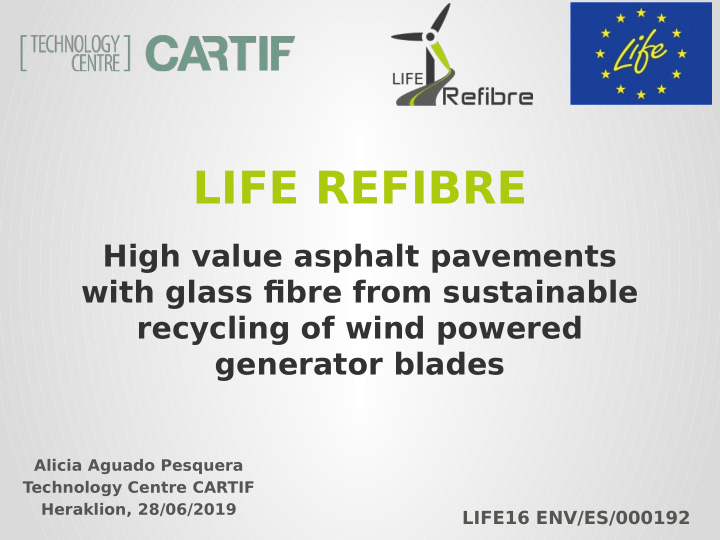



LIFE REFIBRE High value asphalt pavements with glass fjbre from sustainable recycling of wind powered generator blades Alicia Aguado Pesquera Technology Centre CARTIF Heraklion, 28/06/2019 LIFE16 ENV/ES/000192
What is GFRP? GFRP = Glass fjbre reinforced plastic is a composite material, formed by a resin matrix reinforced with glass fjbres. It is very used in several fjelds due to its lightweight, resistance and great rigidity. For example, in aeronautics (airplane wings), in construction (as an enclosure or facades in buildings), in the nautical industry (boat’s hull), automotive sector (parts and car body), health (manufacture of prosthesis), sports (canoes, rackets), etc. LIFE REFIBRE project proposes working with a waste that contains high amounts of GFRP and which is very problematic environmentally blades of wind turbines out of use. 64% GFRP 35% wood 1% other
How comes up? Currently, in Spain, there are 20,306 wind turbines installed in 1,123 wind farms, amount that increases every year. The amount of blades produced by the decommissioning of wind farms with 20 years of antiquity, will be increasing with time. There will be Year 2035 a growing of 500,000 t Source: AEE blades waste blades need to be 324,000 t properly GFRP managed Currently, these blades go to landfjll are an inert compound occupy a high volume generating problems of space. The glass fjbres are not biodegradable from 100 to 4.000 years to decompose. LIFE REFIBRE is proposed to solve the environmental problem that supposes the accumulation of a high amount
LIFE REFIBRE LIFE16 ENV/ES/000192 DATES Start: 01/10/2017 End: 30/09/2020 Duration: 36 months NUMBERS Budget: 1,789,539 € European Contribution: 60%
OBJECTIVES Collection and pre-treatment of blades waste. Design and construction of an innovative prototype plant for the mechanical recycling of blades waste. Recovery the glass fjbres of these blades. Introduction of glass fjbres in asphalt mixtures for the construction of 1.500 meters of road section pavement with difgerent percentages of glass fjbres study its behaviour for a year. Improvement the mechanical properties of the road. Close the life cycle of wind turbine blades waste, giving them an added value by using the recovered glass
Collection and pretreatment • 12 wind turbine blades out of use have been collected from Spanish wind farms 52 tons waste . • Pre-treatment of these blades Consist of a cutting of the blades in the wind farm to reduce the volume facilitate the transport.
Mechanical Recycling The mechanical recycling process has been design in four stages: Separation Separation components by size Hammer Vibrating Hammer Vibrating mill table mill table Secondar Primary y crushing crushing
Mechanical Recycling Pre-treatment
Mechanical Recycling • Primary crushing Hammer mill prototype break the structure of the blades , created between the glass fjbre, the resin, the wood and others minor materials. The design of the hammers, its number and disposition, are very important for the correctly operation of the crushing process four hammers located in the same axis at difgerent heights .
Mechanical Recycling
Mechanical Recycling
Mechanical Recycling • Separation components Due to the diffjculty of separating the difgerent materials of the blades try various separation options: electrostatic separation, separation by water and mechanical screen . Vibrating table separation of the fjbre glass and resin pieces from the rest of the components (basically wood).
Mechanical Recycling
Mechanical Recycling • Secondary crushing Once the glass fjbres are separated from the rest of the components the size of these fjbres are larger than desired secondary crushing achieving the reduction of the size. Hammer mill prototype reduced the size of the glass fjbres obtained previously in the vibrating table. The hammer mill has been optimized to this new crushing variating the residence time which in this crushing will be higher than the primary as well as the striking force.
Mechanical Recycling
Mechanical Recycling • Separation by size The last stage consists of the separation of the glass fjbres by size. Vibrating table size classifjcation modifjcations: bars are removed and sieves are incorporated.
Mechanical Recycling
OBBTAINING RESULTS Collected 12 wind turbine blades out of use 52 tons of waste treated . Design and construction of an innovative mechanical recycling plant of blades waste to obtain glass fjbre. Capacity of 100 kg/h . Recovery of 15 tons of glass fjbres with a size less than 2 cm, avoiding this amount is sent to landfjll Yield of 70% . Study of difgerent asphalt mixtures with the recovered glass fjbres at lab scale 0,00%, 0,50%, 0,75%, 1,00%, 1,25% Resistance to plastic deformation with Marshall device, determination of density and hollows, and water sensitivity.
EXPECTED RESULTS The optimal dosage of the asphalt mixture studied will be applied in fjve demonstrator asphalt pavement segments of 300 metres each one, with a total of 1,500 m , in Zamora, in Spain. For a year, a complete monitoring of this pavement will allow to know the real behaviour, the evolution and the improvement of the mechanical properties due to the introduction of the recovered glass fjbres in the asphalt pavement. These recycled fjbres are expected to improve the next mechanical properties of the pavement: o increasing the road shelf life , o increasing the resistance , o increasing the resilience , o increasing the fatigue resistance , o increasing the rigidity, o increasing the resistance to extreme temperatures
Alicia Aguado Pesquera Technology Centre CARTIF Parque Tecnológico Boecillo Valladolid (Spain) aliagu@cartif.es www.liferefjb re.eu @liferefjbre LIFE
Recommend
More recommend